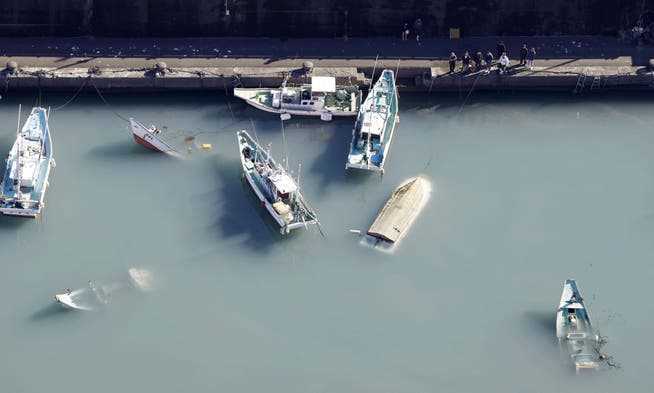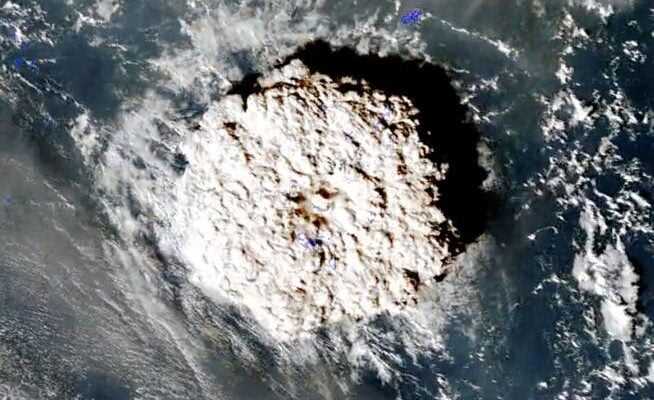There hasn’t been a volcanic eruption as massive as the one in the Pacific over the weekend in decades. The consequences of the eruption are still unclear.
A satellite image from the Japan Meteorological Agency shows the eruption of the underwater volcano.
At 5:15 p.m. local time on January 15, the Hunga Tonga-Hunga Ha’apai underwater volcano ejected a massive ash cloud that rose several kilometers in the air like a mushroom cloud. According to experts, it was the world’s strongest eruption in at least thirty years. The volcano, which is about 60 kilometers from Tonga’s capital Nuku’alofa, erupted for the first time the day before.
Initial data show that there has not been such a violent eruption since Mount Pinatubo erupted in the Philippines in 1991. The eruption in the South Seas has reached level 5 on the eight-level volcanic explosiveness index, in the case of Pinatubo it was level 6, said volcanologist Shane Cronin of the University of Auckland on Monday. If the Hunga Tonga-Hunga-Ha’apai eruption had occurred on land, the effects would have been “apocalyptic,” Cronin said.
The Japanese earthquake and volcano researcher Ryusuke Imura from the University of Kagoshima called the volcanic eruption off Tonga an event that occurs on this scale worldwide only once in a hundred years – or even more rarely.
The island kingdom of Tonga is located in the South Pacific. It includes around 170 islands, 36 of which are uninhabited. The island kingdom is 2400 kilometers north of New Zealand and 800 kilometers east of Fiji. According to estimates, a good 100,000 people live in Tonga, a quarter of them in the capital, Nuku’alofa.
The island kingdom is still largely cut off from the outside world. Because an important submarine cable was severed by the outbreak, the internet went down. It is therefore still completely unclear what damage the eruption caused. In particular, no contact could be made with some of the more remote islands, as the communication links there were also severely impaired on Monday.
The eruption of the underwater volcano triggered tsunamis up to 1.2 meters high in the region. According to the Pacific Tsunami Warning Center, a tsunami wave of 83 centimeters was measured in Nuku’alofa. According to local media, houses were flooded and telephone and electricity connections were interrupted.
According to New Zealand’s High Commissioner in the archipelago, Peter Lund, Nuku’alofa lies buried under a layer of ash and looks like a “lunar landscape”. The west coast of the main island of Tongatapu, where many holiday hotels are located, is also badly affected.
Because of the severely impaired communication links, military aircraft from New Zealand and Australia explored the situation from the air on Monday. Boats and boulders have washed ashore and buildings have been damaged, according to New Zealand Prime Minister Jacinda Ardern.
A major danger is volcanic ash: it could be toxic and contaminate drinking water. Aid organizations therefore warned of health damage from the huge ash clouds and advised the residents of Tonga to wear masks and only drink bottled water.
Because of the poor communication conditions, it is still completely unclear how many people were injured or killed. New Zealand Prime Minister Jacinda Ardern said Sunday there were no official reports on the matter.
The British BBC reported on Monday, citing relatives, that the Body of British woman living in Tonga found had been.
The impact of the outbreak was measurable around the globe. The eruption could even be heard in New Zealand, 2000 kilometers away, and in Fiji.
As a result of Saturday’s eruption, tsunami waves spread across the Pacific, inundating areas in Peru and the United States, including Alaska, Oregon, Washington State and British Columbia, among others. In Japan, 200,000 people were evacuated on Sunday after local meteorological authorities warned of a tidal wave up to 3 meters high. In Peru, two people drowned on a beach in the high waves.

The water level also rose on Japan’s Pacific coast due to the tsunami waves.
The ash plumes triggered by the eruption have now even reached Australia’s east coast, the Weather Watch New Zealand weather service said. The cloud is moving west across Queensland and will cover much of the state during the day, it said.
Yes. According to Prime Minister Jacinda Ardern, New Zealand wants to send important aid supplies to Tonga by sea and air. If the runway in Tonga’s capital, Nuku’alofa, is damaged, the materials could also be jettisoned, Ardern told reporters on Monday. The USA and the United Nations have already pledged help to Tonga.
The priority of the relief work is the water supply of Tonga. Because the volcanic ash could be toxic, the country urgently needs water.
Yes. The undersea volcano has been active again and again since December. Whether the recent eruption represents the peak of activity is unclear, according to volcanologists. It could also be that the volcano remains restless for several weeks or even years.
